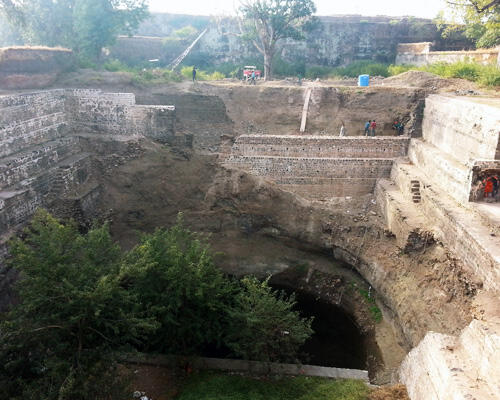Dhar Fort Conservation

Located in the state of Madhya Pradesh, Dhar is an important medieval town and the erstwhile capital of Malwa. It is associated with Raja Bhoj of Paramār dynasty (800 - 1327 A.D.) and is believed to have derived its name from the sharp swords of its rulers. The fort, which is located to the north of the town, has a rock cut reservoir or baoli (stepped well) and a fortification wall of the same period. Gateways and other buildings of the fort are from different periods including Tughlaq, Malwa Sultanate, Mughal, Maratha (Pawar), and British. While the high and tapered fortification with truncated, cone-shaped bastions in different sizes and colors leaves a lasting impression, the interiors—which consists of a large open space, chambers, and tunnels underneath the bastions; hamam (Turkish baths); a horse carriage way; and the remains of canons, stone sculptures, and fragments—require further investigation.
For a conservation architect, it is both a professional opportunity as well as an emotional experience to document and plan conservation for a tenth century fort, or any historic monument for that matter. The process gets enriched with the discoveries made every day, be it finding the slightest remains of historic evidence or uncovering obscured features and at the same time mixed with the painful sights of human errors and interventions. The long days of hard work, after attempting to settle the drawings with missing lines of walls densely covered with vegetation, ends with sitting inside a remote canopy high on the wall and beholding the setting sun’s deep orange hue dazzle the stone. The conservation plan for the fort was prepared with a lot of precision and is a useful document that records each and every building inside the fort complex, prioritizing areas that needed immediate attention within the budget allocated. The work on site started in the beginning of 2014. It is easy to get disappointed with the restrictions of not being able to undertake the entire conservation work at the same time, but there surely is a benefit to sequencing the work with the many challenges thrown around. The shortage of skilled masons and the inadequate training in lime works and other types of repair work are routine challenges which the conservation architect has to face and improve with constant training and guidance along with imparting good site practices.
At the fort, necessary repair works to the baoli, gateways, and fortification were taken up in the same order. The baoli, a large rock cut water reservoir that still holds 10 meter (30 feet) deep water, was added in the fifteenth century. With gradual disintegration of rock, the walls collapsed at places and the exposed soft bed of the rock attracted dense vegetation. It was a challenge for the workmen to uproot the trees without damaging the walls and the rock. The cleaning, repairing, and underpinning of the walls have helped in revealing the original appearance and the large scale of the baoli. Since the rock has receded substantially at the base in some portions, creating the wall against the rock face poses a real challenge. The gateways have been repaired with necessary vegetation removal, the rebuilding of missing and damaged masonry has been done, the battlements have been repaired, and the repair to the terraces to address water seepage issues has been carried out. There are certain challenges with re-plastering because plaster is more vulnerable to damage and decay; it is usually lost leaving the stone masonry exposed. However, plaster being the sacrificial layer helps in protecting the masonry beneath and could be considered as against the philosophy of “conserve as found,” though the policy would vary for ornamental plaster. In case of the fort wall, there is extensive growth of trees and plants which have been carefully uprooted by the experts. It is difficult to erect an efficient scaffolding given the tapered walls and slope rock base. There is blackening of the fort wall caused by the dense algal growth and its associated mucilage. Blackening of the fort wall was not addressed because it is a recurring phenomenon and cannot be completely stopped. Any attempt to clean would aggravate decay by exposing the fresh surface for weathering. Repairing of battlements with the original match locks has been attempted. The work is expected to be completed by July 2015.
As the work progresses and nears completion, there is an interest among the locals and the local administration that regularly follow the work. We are hopeful that their awareness and appreciation would eventually lead to curb the construction activities on the foot hill very close to the fort which is extremely serious and detrimental to the fort’s stability.
WMF has partnered with the government of Madhya Pradesh’s Department of Culture to develop a sustainable management program for continued conservation and maintenance of the state’s heritage sites.
